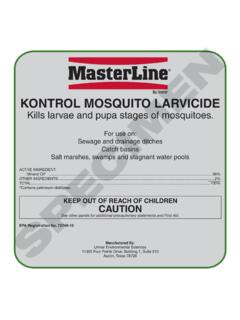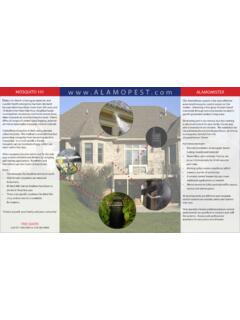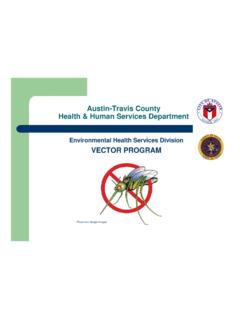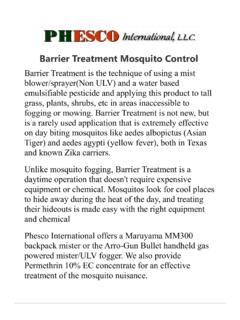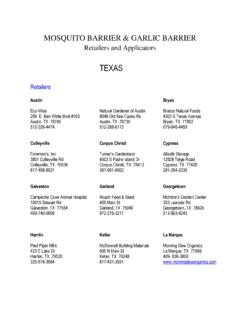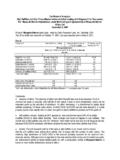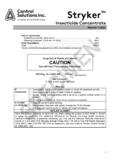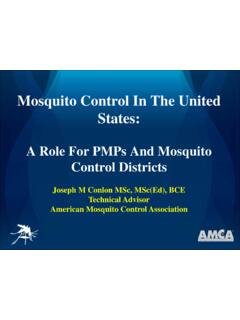Transcription of Michigan Mosquito Control Association Mosquito …
1 Michigan Mosquito Control Association Mosquito Control and Pollinator Protection July 2016 SUMMARY This document provides an overview of the precautions professional Mosquito Control organizations already incorporate to help reduce the risk of Control efforts to pollinators and other beneficial insects. A summary of main points are as follows: Control efforts targeting larval stage mosquitoes offer little to no risk to pollinators. Adult Mosquito management techniques include Ultra Low Volume (ULV) fogging and limited residual spraying. ULV technology is effective for small insects such as mosquitoes, but due to the small amount of material applied, generally does not affect larger insects such as bees. Most ULV applications are done while honey bees and other pollinators are not active.
2 When ULV operations occur earlier in the day, applications are limited to wooded areas away from flowering vegetation to avoid pollinator contact. Residual applications are made to surfaces not commonly contacted by pollinators such as along eaves, under decks and the underside of foliage. Residual insecticides include active ingredients that are not toxic to honey bees. Mosquito Control operations map locations of known apiaries to ensure precautions are taken and proper distance is maintained when applying insecticides. Several Mosquito Control districts/companies employ extra pollinator precautions into their operational plans; avoid nighttime fogging within 300 ft. of honey bee hives and up to 1 mile from hives before sunset.
3 Open and frequent communication with beekeepers and beekeeping organizations occurs to further help avoid unwanted impacts on pollinators. Mosquito Control TECHNIQUES AND POLLINATOR PROTECTION Mosquito Control is not only important for enhanced quality of life, but also for disease prevention. In Michigan , Mosquito -transmitted viruses such as Eastern Equine Encephalitis and West Nile Virus have caused significant human morbidity and mortality. A comprehensive Mosquito Control program has been demonstrated to observably reduce the number of mosquitoes infected with deadly virus (Carney et al. 2008, Hopkins et al. 1975, Walker unpublished data). 2 Integrated Mosquito Management (IMM) is a strategy used by professional Mosquito Control operations and is prescribed to all Michigan category 7F certified applicators.
4 The IMM technique is based on a thorough knowledge of the Mosquito species and disease potential of the operating area. Mosquito Control options such as source reduction, biological Control and chemical Control are evaluated and utilized. More information on IMM can be found in the American Mosquito Control Association document, Best Management Practices for Integrated Mosquito Management Control of mosquitoes is mostly done by targeting the aquatic larvae/pupae or adult Mosquito stages. Depending on the Control technique and active ingredient, this can pose a risk to honey bees and other insect pollinators. Yet, compared with other applications of insecticides, Mosquito Control technology has been shown to offer minimal risk to non-target organisms (Mount 1998).
5 Targeting the larval stage of mosquitoes is effective and involves the least risk to pollinators. Common active ingredients for larvae Control include methoprene, Bacillus thuringiensis israeliensis (Bti) and Bacillus sphaericus (Bs). Methoprene is a hormone mimic that prevents the maturation of mosquitoes beyond the larval stage. Some studies have reported detrimental effects of methoprene on honey bees, however, the research involved direct application of high methoprene doses to bees (Glare 1999). There have been no reports of methoprene treated Mosquito habitats that caused detrimental effects on foraging bees. Furthermore, this seems unlikely given the small amount of methoprene that would be potentially contacted. Bti and Bs are soil bacteria that produce toxins effective at causing Mosquito larval mortality (Lacey 2007).
6 An added benefit of these bacteria is the specificity for mosquitoes and safety for non-target aquatic organisms (Merritt et al. 2005, Brown et al. 2004, Wipfli and Merritt 1994, Miura et al. 1980). As a further testament of Bt safety, a closely related Bacillus thuringiensis strain (ABTS 1857) is safe to use directly in bee hives for Control of Wax Moth. Pyrethroids (synthetic derivatives of the natural insecticide pyrethrum) and organophosphates such as malathion are common classes of adult Mosquito insecticides. These two classes are used for a wide range of insecticidal applications such as agriculture, forestry, horticulture, and public health. Due to their broad efficacy on a number of arthropods, they pose the highest risk to pollinators of the products so far listed (Hester et al.)
7 2001, Hill et al. 1971). A common adult Mosquito Control technology is the use of Ultra Low Volume (ULV) fogging. Ultra Low Volume is delivered by two primary methods, cold fogging or thermal fog. Cold fogging units atomize material into a fine mist through methods such as high powered blowers that create sufficient turbulence to break up material (WHO 2003). Thermal fogging involves the volatilization of formulated material through the use of hot gas from gas-powered combustion. When the heated vapor is released from the fogging unit it cools and condenses into fine droplets (WHO 2003). Thermal and cold fogging ULV can be delivered through handheld or vehicle-mounted fog units. Ultra Low Volume involves very small amounts of material (approximately 1 of active ingredient), which is atomized into optimally sized fine droplets (approximately 10-25 microns) that impinge on flying mosquitoes (Bonds 2012).
8 There is little to no residue left once the fog dissipates and the active ingredient is not carried and introduced to a colony by foraging bees. An added benefit of ULV is that the spray is largely ineffective at impacting larger insects. For instance, Chaskopoulou et al. (2014) assessed the effects of ULV applied pyrethroids to three beneficial insects; honey bees, mealybug 3 destroyers and lacewings. The authors observed no acute mortality, nor sublethal effects on overall bee colony health as measured by colony weight and population numbers. In another study, dragon flies, honey bees, spiders and butterflies were caged and exposed to ULV-applied pyrethrin (Boyce et al. 2007). Again, no mortality was observed among these beneficial insects.
9 The authors attributed the lack of mortality to the size of the insects and the low amount of material applied with ULV. A study was conducted to measure impacts on non-target insects of aerially applied ULV (Kwan et al. 2009). All insects that received a lethal dose were small bodied (<8 mm) consistent with the previous studies where no measureable effect was observed among larger insects. The timing of ULV application is important for optimal Mosquito Control . Mosquitoes should be active at the time of application, which for most species is near or after sunset. Atmospheric conditions at this time of day are also optimal for ULV due to temperature inversions that create a stable air column, which increases the available time for the fog to contact flying mosquitoes.
10 This aids in the avoidance of pollinator contact since most ULV operations are conducted near or after sunset and therefore further minimize the risk to day-active pollinators. An added precaution commonly employed by Mosquito Control districts is maintenance of safe distances from honey bee colonies when applying insecticides. Examples of this include a 300 ft barrier maintained when ULV fogging after sunset and up to 1 mile before sunset. This will additionally help to avoid foraging bee and colony exposure. In Michigan , some mosquitoes, particularly spring woodlot species, are active earlier in the day and will readily bite in woodlands at any time of day. Furthermore, due to the cool temperatures common in the spring, several of these species will begin seeking a blood meal well before sunset.

